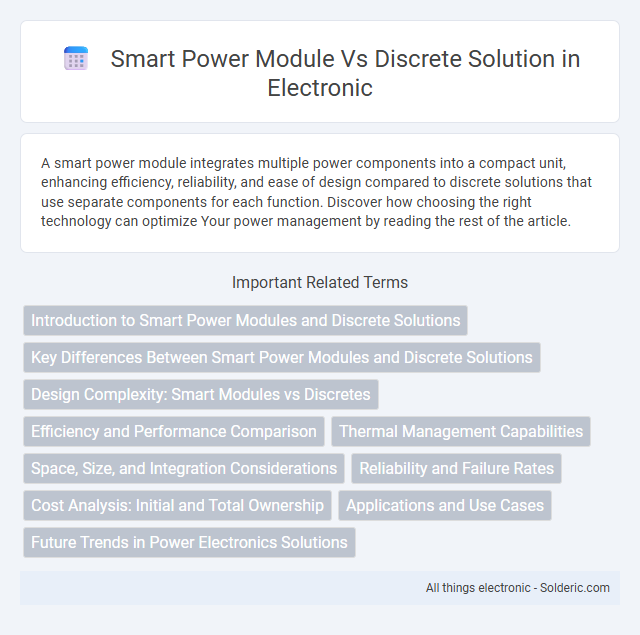A smart power module integrates multiple power components into a compact unit, enhancing efficiency, reliability, and ease of design compared to discrete solutions that use separate components for each function. Discover how choosing the right technology can optimize Your power management by reading the rest of the article.
Comparison Table
| Feature | Smart Power Module (SPM) | Discrete Solution |
|---|---|---|
| Integration | High integration of power devices and control ICs | Individual components for power devices and control |
| Size | Compact, reduced PCB footprint | Larger due to multiple discrete components |
| Thermal Management | Optimized thermal interface, improved heat dissipation | Dependent on external heat sinks and layout |
| Performance | Consistent switching performance with integrated drivers | Variable performance based on component selection |
| Reliability | Higher reliability with fewer interconnections | Lower reliability due to multiple solder joints |
| Design Complexity | Simplified design, faster time-to-market | More complex design, longer development time |
| Cost | Higher unit cost, but lower total system cost | Lower unit cost, but higher system assembly cost |
| Application | Ideal for space-constrained, high-efficiency systems | Suitable for custom or flexible power designs |
Introduction to Smart Power Modules and Discrete Solutions
Smart Power Modules (SPMs) integrate power semiconductor devices with control circuitry in a compact package, offering enhanced efficiency and reliability for motor control and power management applications. Discrete solutions consist of individual power components such as transistors, diodes, and resistors assembled separately, providing greater design flexibility but typically larger size and increased complexity. SPMs reduce assembly time and improve thermal management compared to discrete solutions, making them ideal for high-performance systems requiring compact and robust power control.
Key Differences Between Smart Power Modules and Discrete Solutions
Smart power modules integrate multiple power components with built-in protection and control features, offering a compact and efficient solution compared to discrete solutions that consist of separate individual components assembled on a PCB. Discrete solutions provide greater design flexibility and customization but often require more space, increased wiring complexity, and higher assembly costs. Your choice depends on application requirements such as size constraints, performance optimization, and system integration complexity.
Design Complexity: Smart Modules vs Discretes
Smart power modules significantly reduce design complexity compared to discrete solutions by integrating multiple power components and control circuitry into a single compact package. Discrete solutions require separate selection, layout, and interconnection of individual components, increasing design time and the risk of layout errors. Consequently, smart modules streamline development, improve reliability, and simplify thermal management in power electronics applications.
Efficiency and Performance Comparison
Smart power modules (SPMs) offer higher efficiency and improved performance compared to discrete solutions by integrating multiple power components into a single compact unit, reducing parasitic losses and enhancing thermal management. SPMs typically provide faster switching speeds and lower conduction losses, resulting in better overall power conversion efficiency and reduced energy waste. Discrete solutions often face increased complexity and interconnection losses, making SPMs superior for high-performance applications requiring compact design and reliable thermal control.
Thermal Management Capabilities
Smart power modules (SPMs) offer superior thermal management capabilities compared to discrete solutions by integrating multiple power components within a single package featuring optimized heat dissipation structures. The use of advanced materials such as copper substrates and thermally conductive interfaces in SPMs enhances heat removal efficiency, reducing junction temperatures and improving overall reliability. Discrete solutions often require additional external heat sinks and complex thermal design, resulting in less compact and less efficient thermal performance.
Space, Size, and Integration Considerations
Smart power modules (SPMs) significantly reduce space and size requirements compared to discrete solutions by integrating multiple power components into a single compact package. This consolidation minimizes board real estate, streamlines thermal management, and improves overall system reliability through reduced interconnections. The integrated design of SPMs allows for easier and faster system assembly, making them ideal for applications where space constraints and high power density are critical.
Reliability and Failure Rates
Smart power modules (SPMs) exhibit significantly higher reliability and lower failure rates compared to discrete solutions due to integrated protection features such as overcurrent, overtemperature, and short-circuit safeguards. The compact design of SPMs reduces solder joints and interconnections, minimizing potential failure points and enhancing thermal management efficiency. Discrete solutions, with individual component reliance, often face higher susceptibility to mechanical stress and variable operating conditions, leading to increased failure rates over time.
Cost Analysis: Initial and Total Ownership
Smart power modules typically reduce initial costs by integrating multiple components into a single package, minimizing assembly and testing expenses compared to discrete solutions. Your total ownership cost often decreases due to lower maintenance requirements, improved reliability, and enhanced thermal management inherent in smart modules. Discrete solutions may have higher upfront expenses from complex design and longer production times, resulting in increased overall lifecycle costs.
Applications and Use Cases
Smart power modules excel in applications requiring compact size, high efficiency, and integrated protection features, such as motor drives, automotive electronics, and industrial automation. Discrete solutions offer flexibility for custom circuit designs and are often preferred in low-volume or specialized applications where detailed component selection is critical. Your choice depends on the balance between integration, design complexity, and performance requirements in your specific use case.
Future Trends in Power Electronics Solutions
Future trends in power electronics emphasize the growing adoption of smart power modules (SPMs) over discrete solutions due to their integration of control, protection, and power components that enhance efficiency and reduce design complexity. Advances in wide-bandgap semiconductors like SiC and GaN within SPMs enable higher switching frequencies and improved thermal management, driving performance improvements in electric vehicles and renewable energy systems. The shift towards compact, reliable, and energy-efficient power electronics increasingly favors smart power modules for next-generation applications demanding scalability and enhanced system intelligence.
smart power module vs discrete solution Infographic

 solderic.com
solderic.com